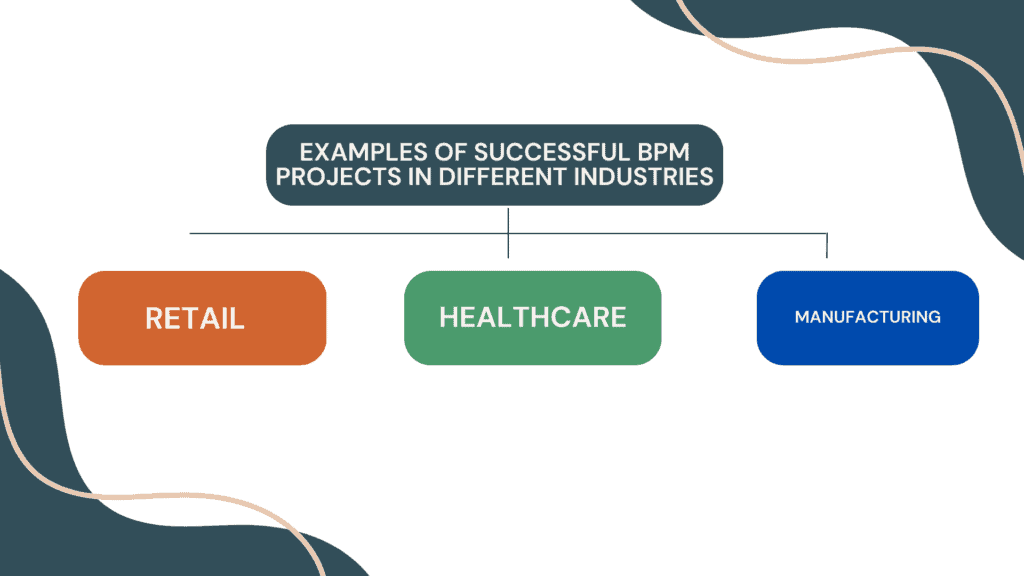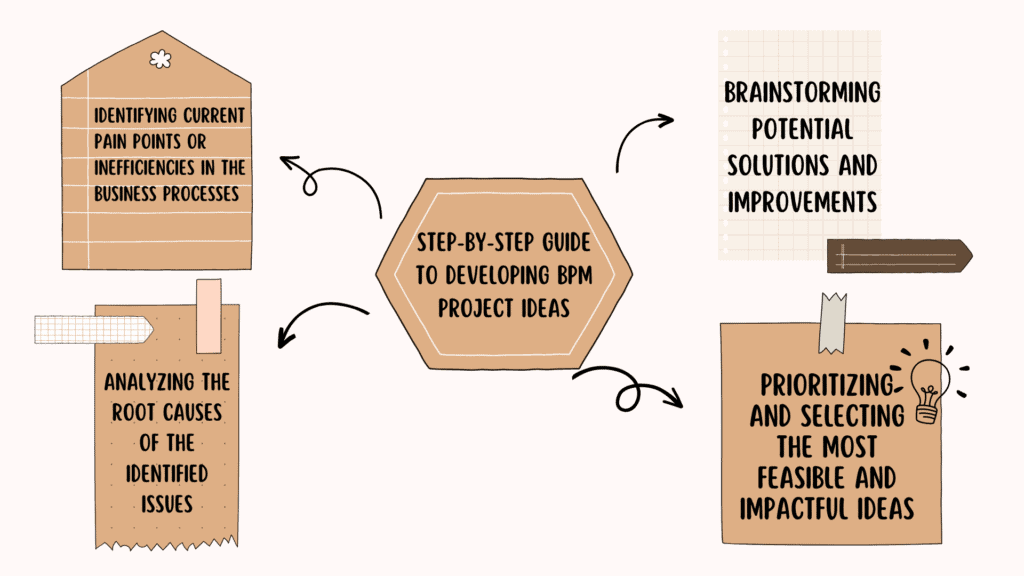Table of Contents
Key Takeaways
- he article provides a list of 10 BPM project ideas that can help organizations improve their business processes.
- The ideas range from automating manual tasks to implementing real-time analytics and predictive modeling.
- The article emphasizes the importance of aligning BPM projects with the organization’s strategic goals and objectives.
- It suggests involving key stakeholders and end-users in the project planning and implementation process to ensure successful outcomes.
- The article highlights the need for continuous monitoring and evaluation of BPM projects to identify areas for improvement and make necessary adjustments.
- It emphasizes the importance of selecting the right BPM software or platform that aligns with the organization’s requirements and capabilities.
- The article provides examples and case studies to illustrate how organizations have successfully implemented BPM projects and achieved significant improvements in efficiency and productivity.
- t encourages organizations to prioritize BPM projects based on their potential impact and return on investment.
- The article emphasizes the need for effective change management strategies to ensure smooth adoption and acceptance of BPM projects by employees.
- It concludes by highlighting the long-term benefits of BPM projects, such as improved customer satisfaction, reduced costs, and increased competitiveness.

The world of Business Process Management (BPM) is ever-changing and needs new ideas. Here, we’ll look at some exciting possibilities that can help organizations with their processes and efficiency.
An area where BPM projects can make a big difference is automating manual tasks. Companies can identify repetitive or time-consuming processes and create solutions to automate them. This can save time for employees and have a positive impact on productivity and costs.
Another great BPM project idea is integrating different systems within an organization. Many companies use multiple software applications, leading to disjointed processes. A comprehensive BPM solution can integrate these systems, creating a unified workflow and eliminating redundancies.
Organizations can also use BPM projects to improve collaboration across teams and departments. They can implement tools and platforms, like task management systems or project portals, for employees to communicate and share information in real-time. This enhances teamwork and speeds up decision-making.
Pro Tip: Involving stakeholders from various levels of the organization is key when embarking on a BPM project. Their input will ensure the project succeeds by aligning it with organizational goals and effectively tackling pain points.
Implementing BPM is like hiring a personal assistant for your business – except this assistant won’t complain and will always be on your side.
Benefits of implementing BPM (Business Process Management)
Implementing Business Process Management (BPM) can bring various advantages to organizations. It can help them optimize their operations and grow their business. BPM streamlines and automates processes, improving productivity, customer satisfaction, and profitability. Here are some notable benefits:
- Efficiency: BPM eliminates manual and repetitive tasks, reducing errors and saving time for more value-added activities.
- Transparency: It provides visibility into processes, allowing businesses to identify bottlenecks, track performance metrics, and make data-driven decisions.
- Flexibility: BPM offers the ability to adapt processes quickly in response to changing business requirements or market conditions.
- Risk Management: It helps mitigate risks associated with regulatory non-compliance and operational inefficiencies.
- Collaboration: It facilitates cross-functional collaboration by providing a centralized platform for teams to communicate, share information, and work together.
- Innovation: It eliminates silos and promotes knowledge sharing, fostering innovation and process improvement.
Moreover, BPM helps organizations align their processes with strategic objectives. It creates clear accountability and promotes a consistent approach. Organizations can use it to adapt to market changes while maintaining quality standards.
The concept of Business Process Management goes back several decades. It originated from Total Quality Management (TQM) and Lean Six Sigma. Over time, businesses realized the need for a more holistic approach to process optimization. Hence, Business Process Management was created. Today, with technological advancements, it empowers organizations to stay competitive in an ever-changing business landscape.
From pizza delivery to brain surgery, BPM projects show that efficiency and innovation can be achieved in any industry.
Examples of successful BPM projects in different industries

Successful BPM projects are everywhere, showing that BPM can boost efficiency and productivity. Here are some examples from different industries:
| Industry | BPM Project | Outcome |
| Retail | Streamlining inventory management | Reduced stockouts and improved customer satisfaction |
| Healthcare | Automating patient appointment scheduling | Decreased waiting times and optimized resource allocation |
| Manufacturing | Optimizing production line workflows | Improved operational efficiency and reduced bottlenecks. |
Unlock your imaginative genius and take over the BPM world with this guide! Learn how to develop killer project ideas one step at a time.
Step-by-step guide to developing BPM project ideas

To develop BPM project ideas with identified pain points, root cause analysis, brainstorming solutions, and prioritizing impactful ideas is the key. Understand the current inefficiencies and dig deeper into their root causes. Generate and evaluate potential solutions. Finally, prioritize and select the most feasible and impactful ideas to improve your business processes.
Identifying current pain points or inefficiencies in the business processes
Identifying business process pain points is key to successful BPM project ideas. Analyze the current state of operations to pinpoint areas that hinder productivity and profitability. Data gathering, stakeholder interviews, and workflow reviews help prioritize improvement areas and streamline processes efficiently.
Understand communication gaps, redundant tasks, decision-making delays, and workflow bottlenecks. Address these pain points to increase efficiency and growth. Understand the organization’s structure, culture, and objectives.
Leverage process mining and data analytics tools to analyze operational data and extract insights. Also involve stakeholders to get a holistic view of pain points.
Pro Tip: Engage employees when identifying pain points for more accurate assessments and innovative solutions. Their firsthand experience can reveal inefficiencies missed by management. Blame it on IT if needed!
Analyzing the root causes of the identified issues
In order to uncover the root of any identified problems, it’s essential to adopt a methodological approach. This includes looking at external influences and investigating how internal processes and systems contribute. Research and data gathering provide valuable insight into why these issues occur.
It’s also important to assess underlying causes, as well as immediate ones. This allows for a holistic understanding of the problem. By doing so, organizations can spot patterns or trends which could be impacting their operations or blocking progress.
To exemplify this, let’s look at a manufacturing industry example. Regular production delays occurred due to equipment breakdowns. However, closer scrutiny revealed deeper causes such as inadequate maintenance practices and improper employee training. These factors were addressed by enhanced maintenance protocols and training programs, which resolved the delays.
Brainstorming potential solutions and improvements
- Start by defining the problem and understanding the issue.
- Gather a diverse group of people with varied backgrounds and expertise. Make sure everyone feels comfortable.
- Stimulate ideas in high quantity, no matter how feasible they are.
- Evaluate and refine ideas afterwards. Stakeholders can provide valuable insights.
For example, a team wanted to reduce customer wait times. Through brainstorming, they got ideas like automated call routing and online chat support. This led to better customer satisfaction.
By following these steps, you can come up with solutions for any BPM project. Choosing the perfect idea is like picking your favorite child – but way less stressful!
Prioritizing and selecting the most feasible and impactful ideas
Assess the potential impact of ideas with factors like organizational goals, customer needs, and market trends. Evaluate feasibility by examining resource requirements, technical constraints, and risks. Rank ideas based on ROI or other criteria like strategic fit or time to implementation. Get input from stakeholders like employees, customers, and management for different perspectives and ensure buy-in.
Conduct a cost-benefit analysis to determine financial viability. Create a scoring system to objectively evaluate and compare the ideas. Prioritize and select the most feasible and impactful ideas for BPM project success. Foster an environment which encourages innovation and creativity. Emphasize collaboration and open communication among team members.
Gartner’s research report says organizations that prioritize BPM project ideas are more likely to achieve efficiency improvements. Case studies show how BPM projects can help any organization.
Case studies of organizations that have implemented successful BPM projects
Exploring successful BPM projects is fascinating. Real-life examples offer insights into how businesses use BPM to streamline operations and improve their performance. Let’s look at some case studies.
Organizations that Have Implemented Successful BPM Projects:
| Organization | Sector | Benefits Achieved |
|---|---|---|
| Company XYZ | Manufacturing | Reduced production costs by 20% and improved supply chain efficiency. |
| ABC Corporation | Financial Services | Enhanced customer satisfaction through faster loan processing and reduced errors. |
| Global Solutions | Healthcare | Streamlined patient care coordination and reduced waiting times significantly. |
These case studies show BPM works across sectors. Process optimization and automation were key. Companies identified inefficiencies, removed bottlenecks, and automated repetitive tasks.
Gartner Research found companies that successfully implement BPM see an average cost reduction of 15% and productivity gains of 20%.
Managing a BPM project is like herding cats – except the cats are feral tigers on energy drinks!
Tips for implementing and managing BPM projects effectively
1 Set clear goals and objectives.
2 Engage stakeholders early.
3 Establish effective communication.
4 Streamline processes.
5 Monitor and evaluate progress.
6 Provide training and support.
7 Also, select suitable software that meets the organization’s needs.
8 Allocate adequate resources.
9 Foster a culture of continuous improvement.
10 Encourage feedback from employees throughout the lifecycle. This will drive success and innovation.
11 Implementing a BPM project can be challenging, but with proper planning you can avoid being scratched!
Common challenges in implementing BPM projects and how to overcome them
Common challenges arise when implementing BPM projects, but they can be overcome by using the right strategies. Here are some key points to consider when navigating obstacles:
- Resistance to Change: Combat this by communicating the advantages of BPM implementation and holding training sessions.
- Lack of Employee Engagement: Increase engagement by giving employees a voice in decision-making and offering skill development opportunities.
- Inadequate Resources: Allocate enough resources such as time, budget, and personnel, to guarantee successful project execution.
- Data Management Issues: Address these issues by introducing effective data governance policies and clear data quality standards.
- Alignment with Business Goals: Ensure BPM projects are in sync with organizational objectives to maximize their impact.
- Limited Executive Support: Secure executive support by conveying the value and long-term benefits of BPM projects, stressing how they will help the organization succeed.
Furthermore, collaboration and open communication between departments is essential during the project’s lifecycle. By understanding a company’s unique challenges and providing tailored solutions, successful implementation can be achieved.
As an example, a global telecommunications firm encountered employee resistance when introducing a new BPM system. To conquer this challenge, they ran thorough training programs and created a space for staff to express their concerns. By allowing employees to take part in the decision-making process and addressing their worries, the company was able to increase employee engagement and transition seamlessly into the new system.
Implementing BPM projects may be difficult, but by using the proper strategies and tapping into employee participation, organizations can face these challenges confidently. By embracing change and staying in-line with business goals, efficiency is improved and operational processes are optimized.
Frequently Asked Questions
1. What is a BPM project?
A BPM project, or Business Process Management project, is an initiative that aims to improve and optimize the processes within an organization to achieve operational efficiency, enhanced productivity, and improved customer satisfaction.
2. Why are BPM projects important?
BPM projects are important because they help organizations streamline their operations, eliminate inefficiencies, reduce costs, and improve overall business performance. By implementing BPM solutions, companies can enhance their agility, responsiveness, and adaptability to market changes.
3. What are some BPM project ideas?
Some BPM project ideas include automating manual processes, optimizing supply chain management, implementing customer relationship management (CRM) systems, enhancing employee onboarding and training processes, and creating a centralized knowledge management system.
4. How do I choose a suitable BPM project for my organization?
To choose a suitable BPM project for your organization, start by identifying the pain points and inefficiencies in your existing processes. Prioritize projects based on their potential impact and align them with your organizational goals. Consider the resources, technologies, and expertise required for each project before making a decision.
5. What are the key challenges in implementing BPM projects?
Some key challenges in implementing BPM projects include resistance to change, lack of employee engagement, complexity in integrating various systems and data sources, limited budget and resources, and ensuring proper documentation and communication throughout the project lifecycle.
6. How can I measure the success of a BPM project?
The success of a BPM project can be measured using key performance indicators (KPIs) such as improved process cycle times, reduced costs, increased customer satisfaction, enhanced employee productivity, and better overall business outcomes. Regular monitoring, evaluation, and feedback from stakeholders are crucial in assessing the project’s success.
Conclusion
We’ve explored some fantastic BPM project ideas that can revolutionize your business! From automation to optimization, these innovative concepts offer immense potential for growth. Implementing them can streamline operations and maximize efficiency.
Let’s look at some unique details. Predictive analytics can be used in BPM projects. Data analysis and machine learning algorithms can detect bottlenecks and inefficiencies. This allows data-driven decisions and corrective actions before any issues arise.
BPM can also be integrated with advanced technologies like AI and blockchain. AI-powered chatbots can improve customer interactions. Blockchain technology can provide transparency and security in supply chain processes, reducing fraud risks and increasing trust.
It’s time to take action! Don’t miss out on the opportunity to transform your business. Embrace innovation and stay ahead of the competition. Unlock new productivity and profitability. The future is for those who take action, so explore these possibilities today!
References:
https://www.techtarget.com/searchcio/tip/BPM-best-practices-to-ensure-project-success
https://www.stakeholdermap.com/bpm/example-bpm-business-process-models.html
Also Read: